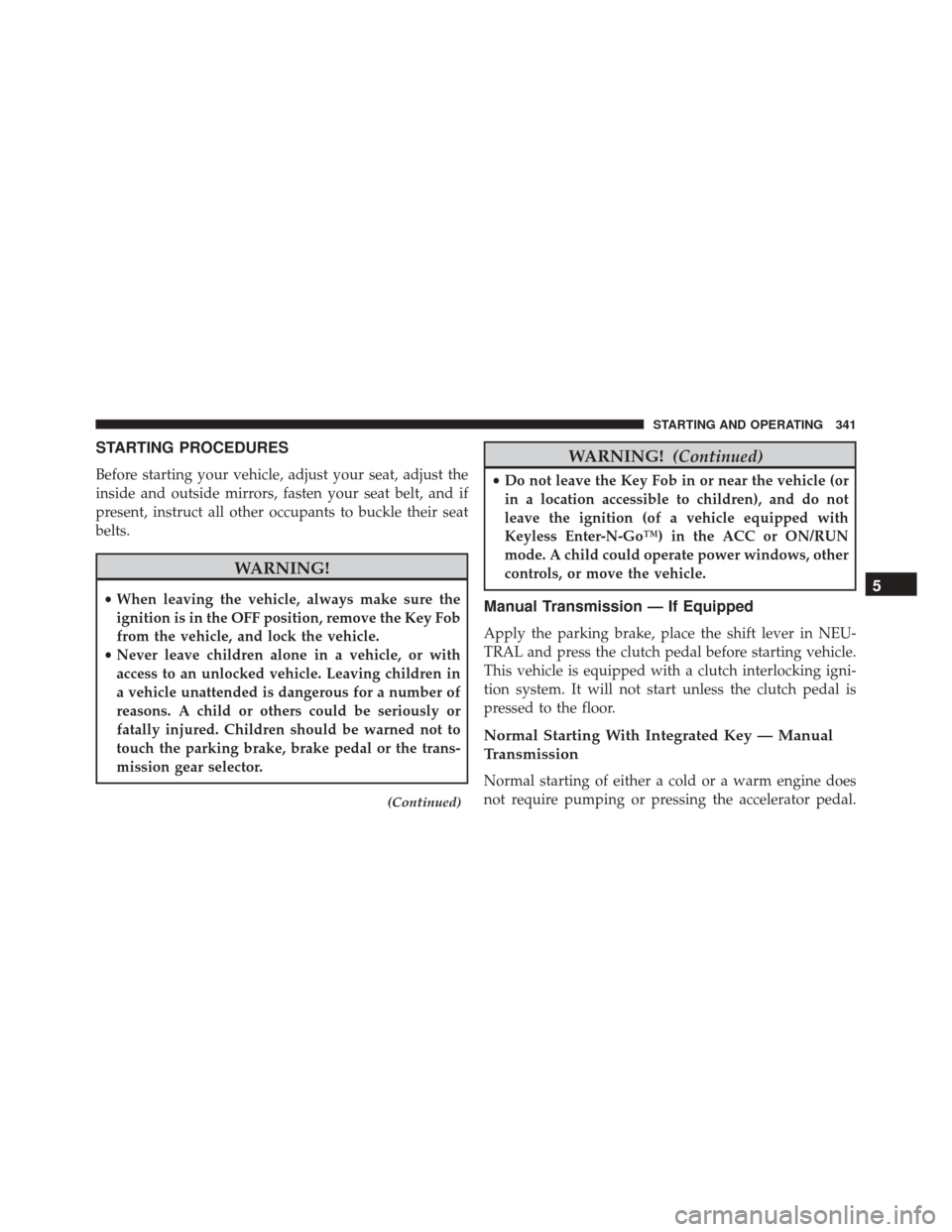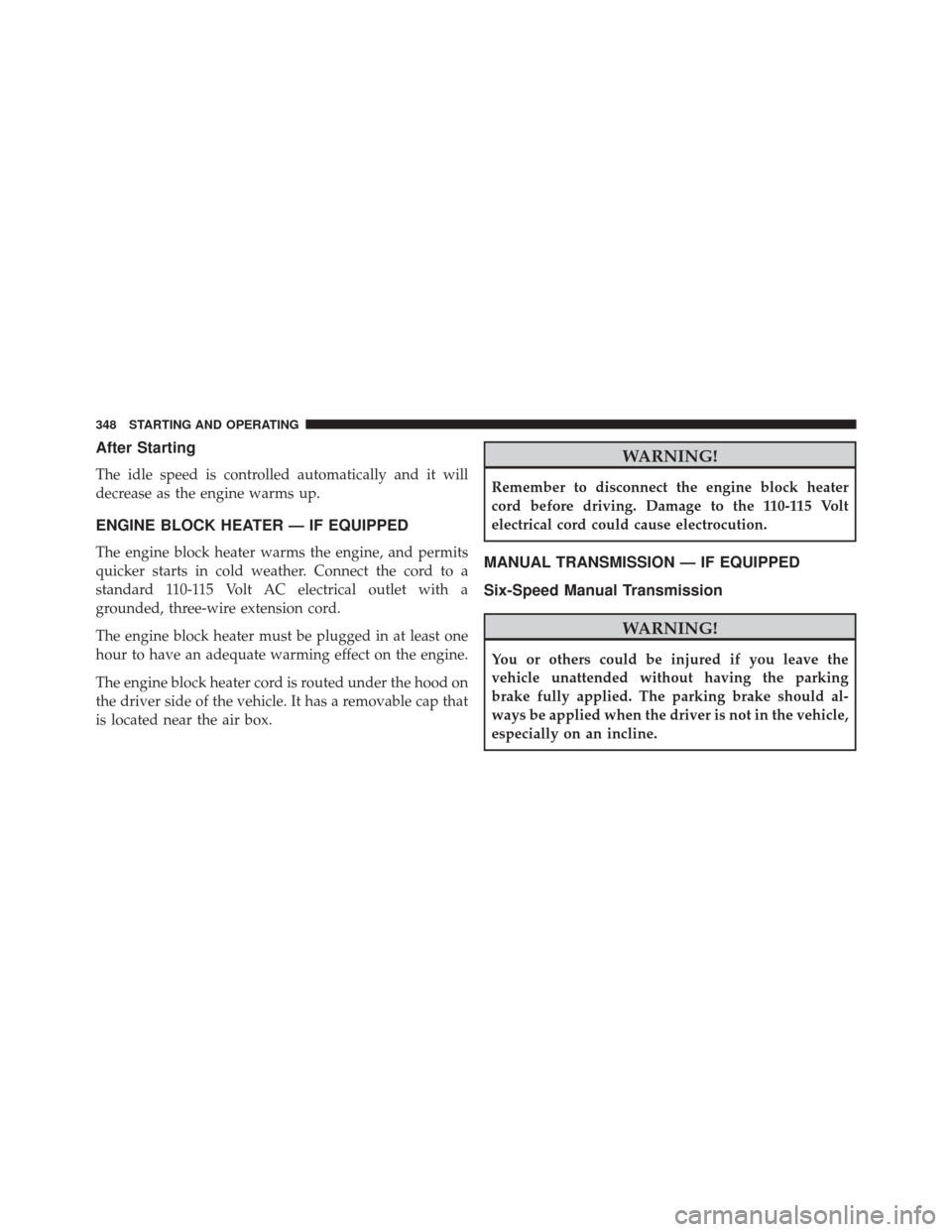Page 307 of 575

ECO Mode — If Equipped With Automatic
Transmission
Press the “Eco” button on the touchscreen on the SRT
Drive Modes main menu. Eco mode modifies the vehi-
cle’s engine and transmission settings to provide im-proved fuel economy at a trade-off with acceleration
performance. Increased engine exhaust noise and/or
vibration may be noticed while Eco is active. This is
normal and a result of the increased amount of operating
conditions where the vehicle is allowed to operate in four
cylinder shutoff mode (6.4L Only).
The Paddle Shifters will be disabled while in Eco mode.
•
Changing the Drive Mode will deactivate Eco.
• Eco will be disabled when another Drive Mode is
selected or “Eco” button is pressed.
Uconnect® RADIOS — IF EQUIPPED
For detailed information about your Uconnect® radio,
refer to your Uconnect® Supplement Manual.
iPod®/USB/MP3 CONTROL — IF EQUIPPED
This feature allows an iPod® or external USB device to be
plugged into the USB port.
Eco Mode
4
UNDERSTANDING YOUR INSTRUMENT PANEL 305
Page 339 of 575
STARTING AND OPERATING
CONTENTS
�STARTING PROCEDURES ................341
▫ Manual Transmission — If Equipped ........341
▫ Automatic Transmission — If Equipped .....342
▫ Keyless Enter-N-Go™ ..................343
▫ Normal Starting ...................... .343
▫ Extreme Cold Weather
(Below –20°F Or �29°C) ................346
▫ If Engine Fails To Start .................346
▫ After Starting ....................... .348
� ENGINE BLOCK HEATER — IF EQUIPPED . . .348 �
MANUAL TRANSMISSION — IF EQUIPPED . .348
▫ Six-Speed Manual Transmission ...........348
▫ Shifting ............................ .350
▫ Recommended Shift Speeds ..............351
▫ 1–4 Skip Shift ....................... .352
▫ Downshifting ....................... .352
� AUTOMATIC TRANSMISSION ............353
▫ Key Ignition Park Interlock ...............354
▫ Brake/Transmission Shift Interlock System . . .354
5
Page 340 of 575

▫Eight-Speed Automatic Transmission — If
Equipped .......................... .355
� AUTOSTICK ......................... .362
▫ Steering Wheel Mounted Paddle Shifters Or
Console Mounted Shifter ................362
� DRIVE MODES ....................... .365
▫ Launch Mode — If Equipped .............370
▫ Guidelines For Track Use ................374
� DRIVING ON SLIPPERY SURFACES .........377
▫ Acceleration ........................ .377
▫ Traction ........................... .377
� DRIVING THROUGH WATER .............378
▫ Flowing/Rising Water ..................378
� POWER STEERING — 6.4L ENGINE .........380�
POWER STEERING — 6.2L SUPERCHARGED
ENGINE ............................ .381
�
FUEL SAVER TECHNOLOGY — IF EQUIPPED. . .382
� PARKING BRAKE ..................... .382
▫ Manual Transmission — If Equipped ........383
▫ Automatic Transmission — If Equipped ......383
� BRAKE SYSTEM ...................... .385
� ELECTRONIC BRAKE CONTROL SYSTEM . . . .386
▫ Anti-Lock Brake System (ABS) ............386
▫ Traction Control System (TCS) ............389
▫ Brake Assist System (BAS) ...............389
▫ Hill Start Assist (HSA) .................390
▫ Electronic Stability Control (ESC) ..........391
338 STARTING AND OPERATING
Page 343 of 575

STARTING PROCEDURES
Before starting your vehicle, adjust your seat, adjust the
inside and outside mirrors, fasten your seat belt, and if
present, instruct all other occupants to buckle their seat
belts.
WARNING!
•When leaving the vehicle, always make sure the
ignition is in the OFF position, remove the Key Fob
from the vehicle, and lock the vehicle.
• Never leave children alone in a vehicle, or with
access to an unlocked vehicle. Leaving children in
a vehicle unattended is dangerous for a number of
reasons. A child or others could be seriously or
fatally injured. Children should be warned not to
touch the parking brake, brake pedal or the trans-
mission gear selector.
(Continued)
WARNING! (Continued)
•Do not leave the Key Fob in or near the vehicle (or
in a location accessible to children), and do not
leave the ignition (of a vehicle equipped with
Keyless Enter-N-Go™) in the ACC or ON/RUN
mode. A child could operate power windows, other
controls, or move the vehicle.
Manual Transmission — If Equipped
Apply the parking brake, place the shift lever in NEU-
TRAL and press the clutch pedal before starting vehicle.
This vehicle is equipped with a clutch interlocking igni-
tion system. It will not start unless the clutch pedal is
pressed to the floor.
Normal Starting With Integrated Key — Manual
Transmission
Normal starting of either a cold or a warm engine does
not require pumping or pressing the accelerator pedal.
5
STARTING AND OPERATING 341
Page 346 of 575

3. The system takes over and attempts to start thevehicle. If the vehicle fails to start, the starter will
disengage automatically after 10 seconds.
4. If you wish to stop the cranking of the engine prior to the engine starting, push the button again.
NOTE: Normal starting of either a cold or a warm engine
is obtained without pumping or pressing the accelerator
pedal.
Using The ENGINE START/STOP Button —
Manual Transmission Only
1. Press and hold the clutch pedal while pushing and holding the ENGINE START/STOP button.
2. Release the button when the engine starts. If the vehicle fails to start within 15 seconds, release the
button, wait 10 to 15 seconds, then repeat the “Normal
Starting” procedure. 3. If you wish to stop the cranking of the engine prior to
the engine starting, release the button.
NOTE: Normal starting of either a cold or a warm engine
is obtained without pumping or pressing the accelerator
pedal.
To Turn Off The Engine Using ENGINE
START/STOP Button — Automatic Transmission
Only
1. Place the shift lever in PARK, then push and release the ENGINE START/STOP button.
2. The ignition switch will return to the OFF position.
3. If the shift lever is not in PARK, the ENGINE START/ STOP button must be held for two seconds and vehicle
speed must be above 5 mph (8 km/h) before the
engine will shut off. The ignition switch position will
remain in the ACC position until the shift lever is in
PARK and the button is pushed twice to the OFF
344 STARTING AND OPERATING
Page 347 of 575

position. If the shift lever is not in PARK and the
ENGINE START/STOP button is pushed once, the
Driver Information Display (DID) will display a “VE-
HICLE NOT IN PARK” message and the engine will
remain running. Never leave a vehicle out of the
PARK position, or it could roll.
NOTE: If the ignition switch is left in the ACC or RUN
(engine not running) position and the transmission is in
PARK, the system will automatically time out after 30
minutes of inactivity and the ignition will switch to the
OFF position.
To Turn Off The Engine Using ENGINE
START/STOP Button — Manual Transmission
Only
1. With the vehicle stopped, place the shift lever in NEUTRAL, then push and release the ENGINE
START/STOP button. 2. The ignition switch will return to the OFF position.
3. Place the shift lever in first gear or REVERSE and then
apply the parking brake.
NOTE:
• If the ignition switch is left in the ACC position, the
system will automatically time out after 30 minutes of
inactivity and the ignition will switch to the OFF
position.
• If the ignition switch is left in the RUN position, the
system will automatically time out after 30 minutes of
inactivity if the vehicle speed is 0 mph (0 km/h) and
the engine is not running.
• If the vehicle speed is above 5 mph (8 km/h), the
ENGINE START/STOP button must be held for two
seconds before the engine will shut off. The ignition
5
STARTING AND OPERATING 345
Page 349 of 575

WARNING!(Continued)
could enter the catalytic converter and once the
engine has started, ignite and damage the converter
and vehicle.
• If the vehicle has a discharged battery, booster
cables may be used to obtain a start from a booster
battery or the battery in another vehicle. This type
of start can be dangerous if done improperly. Refer
to “Jump-Starting” in “What To Do In Emergen-
cies” for further information.
Clearing A Flooded Engine (Using ENGINE
START/STOP Button) — Automatic Transmission
Only
If the engine fails to start after you have followed the
“Normal Starting” or “Extreme Cold Weather� proce-
dures, it may be flooded. To clear any excess fuel, press
and hold the brake pedal, press the accelerator pedal all the way to the floor and hold it, then push and release the
ENGINE START/STOP button once. The starter motor
will engage automatically, run for 10 seconds, and then
disengage. Once this occurs, release the accelerator pedal
and the brake pedal, wait 10 to 15 seconds, then repeat
the “Normal Starting” procedure.
Clearing A Flooded Engine (Using ENGINE
START/STOP Button) — Manual Transmission
Only
If the engine fails to start after you have followed the
“Normal Starting” or “Extreme Cold Weather�
proce-
dures, it may be flooded. To clear any excess fuel, press
and hold the clutch pedal, press the accelerator pedal all
the way to the floor and hold it, then push and hold the
ENGINE START/STOP button for no more than 15
seconds. Release the accelerator pedal and the clutch
pedal, wait 10 to 15 seconds, then repeat the “Normal
Starting” procedure.
5
STARTING AND OPERATING 347
Page 350 of 575

After Starting
The idle speed is controlled automatically and it will
decrease as the engine warms up.
ENGINE BLOCK HEATER — IF EQUIPPED
The engine block heater warms the engine, and permits
quicker starts in cold weather. Connect the cord to a
standard 110-115 Volt AC electrical outlet with a
grounded, three-wire extension cord.
The engine block heater must be plugged in at least one
hour to have an adequate warming effect on the engine.
The engine block heater cord is routed under the hood on
the driver side of the vehicle. It has a removable cap that
is located near the air box.
WARNING!
Remember to disconnect the engine block heater
cord before driving. Damage to the 110-115 Volt
electrical cord could cause electrocution.
MANUAL TRANSMISSION — IF EQUIPPED
Six-Speed Manual Transmission
WARNING!
You or others could be injured if you leave the
vehicle unattended without having the parking
brake fully applied. The parking brake should al-
ways be applied when the driver is not in the vehicle,
especially on an incline.
348 STARTING AND OPERATING